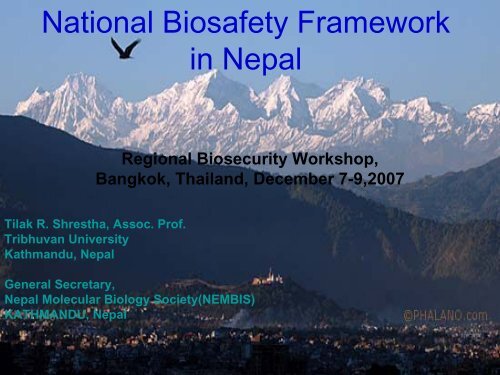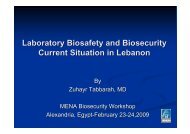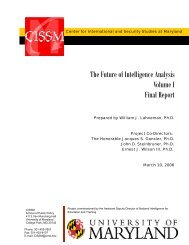Biosecurity: Status and Policy in Nepal - Center for International and ...
Biosecurity: Status and Policy in Nepal - Center for International and ...
Biosecurity: Status and Policy in Nepal - Center for International and ...
You also want an ePaper? Increase the reach of your titles
YUMPU automatically turns print PDFs into web optimized ePapers that Google loves.
National Biosafety Framework<br />
<strong>in</strong> <strong>Nepal</strong><br />
Regional <strong>Biosecurity</strong> Workshop,<br />
Bangkok, Thail<strong>and</strong>, December 7-9,2007<br />
Tilak R. Shrestha, Assoc. Prof.<br />
Tribhuvan University<br />
Kathm<strong>and</strong>u, <strong>Nepal</strong><br />
General Secretary,<br />
<strong>Nepal</strong> Molecular Biology Society(NEMBIS)<br />
KATHMANDU, <strong>Nepal</strong>
Country Background<br />
• South of Himalayan Range<br />
• Between Ch<strong>in</strong>a <strong>and</strong> India<br />
• Area 1,47,181sq.km<br />
• Elevation 60 m to 8848m-Mt. Everest<br />
• Hills <strong>and</strong> high mounta<strong>in</strong>-86%<br />
• Terai pla<strong>in</strong>-14% of total area of nation
Biological Diversity<br />
Climatic Diversity<br />
Peculiar Geographical<br />
Structure<br />
Climatic diversity- Diversity <strong>in</strong> habitat, plants <strong>and</strong> animals<br />
Seasonal variation-ra<strong>in</strong>s <strong>in</strong> monsoon, snowfall <strong>in</strong> w<strong>in</strong>ter, high temt. <strong>in</strong> summer<br />
One season- different climate <strong>in</strong> different l<strong>and</strong>scape of nation<br />
This is one of the reason <strong>for</strong> species diversity
Species Diversity<br />
Species Diversity differs with elevation of <strong>Nepal</strong><br />
High Mounta<strong>in</strong> – above 3000m<br />
- Covers 78.52% of total area,<br />
- 38 ecosystems <strong>in</strong> this region<br />
The middle hill region-1000 to 3000m above sea level<br />
- Biodiversity rich areas- 32% of total <strong>for</strong>est,<br />
- Terai-Siwalik range- 60 to 1000m- imporatnt ecosystem<br />
- 5 protected areas <strong>in</strong> this region <strong>for</strong> world’s endangered species<br />
- Chitawan National Park – World heritage site
1-Biodiversity:<br />
• <strong>Nepal</strong> Geographically small but rich <strong>in</strong> biodiversity<br />
• <strong>Nepal</strong> represents-0.1% of terrestrial area of the earth but<br />
• Has 118 ecosystem, higher presence of diff. flora <strong>and</strong> fauna<br />
• 15 sps. of vascular plants, 58 sps. of mammals, 40 sps. of<br />
birds,<br />
• 13 sps. of reptiles, 2 sps. of <strong>in</strong>sects <strong>and</strong> 1 sps. of amphibian<br />
belons to CITES list.<br />
• 342 plant sps & 160 animal sps. are Endemic to <strong>Nepal</strong><br />
• Biodiversity closely l<strong>in</strong>ks to –<br />
• <strong>Nepal</strong>ese livelihoods, economic development, agricultural<br />
system, human health <strong>and</strong> prote<strong>in</strong>, construction material, water<br />
resource & society’s cultural values.<br />
• Source: <strong>Nepal</strong> Biodiversity Strategy (NBS), 2002
<strong>Nepal</strong>’s richness <strong>in</strong> Organism as Compared to the World<br />
Gr. Of Organism<br />
Lichens<br />
Fungi<br />
Algae<br />
Bryophytes<br />
Pteridophytes<br />
Gymnosperm<br />
Angiosperm<br />
Spider<br />
Other <strong>in</strong>sects<br />
Butterflies & Moths<br />
Birds (>850sps)<br />
Reptiles<br />
Amphibians<br />
Fishes<br />
Mammals<br />
Sources:NBS, 2002<br />
<strong>Nepal</strong>’s representation as compared to<br />
the no. of species <strong>in</strong> the world<br />
2.3<br />
2.4<br />
2.6<br />
5.1<br />
3.4<br />
5.1<br />
2.7<br />
0.2<br />
0.7<br />
2.6<br />
9.3<br />
1.6<br />
1.0<br />
1.0<br />
4.5
<strong>Nepal</strong>’s biosafety policy is based on<br />
precautionary pr<strong>in</strong>ciple:<br />
• And based on conservation of rich<br />
biodiversity<br />
• Protective measures <strong>for</strong> <strong>in</strong>digenous<br />
agricultural system<br />
• Srict regulation on GMO, LMO & Hybrid & its<br />
transboundary movement<br />
• But less attention on pathogen, microorganism<br />
& possible bioterrorism<br />
• Development & application of Biotechnology where<br />
comparative benefits can be achieved.
<strong>Nepal</strong>’s <strong>in</strong>ternational obligation<br />
• Commitment to Biosafety by Sign<strong>in</strong>g the Cartagena Protocol- 2 nd March<br />
2002<br />
• To pay attention to transboundary movement of GMOs, on the basis of<br />
advanced <strong>in</strong><strong>for</strong>med agreement.<br />
• Laws <strong>and</strong> policies related to the release, use <strong>and</strong> market<strong>in</strong>g of GMOs<br />
have to be <strong>for</strong>mulated as per the provision of the Cartagena Protocol.
2:<strong>Policy</strong> Aspects of Biosafety <strong>in</strong> <strong>Nepal</strong><br />
1- Sustenable Development Agenda 2003<br />
2- Millenium Development Goals (MDGs) 2000<br />
3- The Tenth Plan (2002 – 2007)-stress on biotech, bioeng. & biosafety.<br />
4- <strong>Nepal</strong> Biodiversity Strategy, 2002<br />
5- <strong>Nepal</strong> Biodiversity Strategy Implementation Plan(NBSIP)-2006-07<br />
6- National Wetl<strong>and</strong> <strong>Policy</strong>, 2002<br />
7- Science & Technology <strong>Policy</strong>, 2002<br />
8- Biotechnology <strong>Policy</strong>, 2006<br />
9- Biosafety Guidel<strong>in</strong>es, 2005 by M<strong>in</strong>st. Of Forest & soil Conservation<br />
10- Agricultural <strong>Policy</strong>, 2005<br />
11- National Seed <strong>Policy</strong>, 1997<br />
12-National Biosafety <strong>Policy</strong>, March 1, 2007
Legal provisions relat<strong>in</strong>g to biosafety<br />
Although not specific, many legal provisions are found to have <strong>in</strong> place long be<strong>for</strong>e<br />
the emergence of the concept of biosafety itself.<br />
1- Local self governance act 1999.<br />
2- Consumer protection act, 1997<br />
3- The export import act, 1956<br />
4- Plant protection act, 1972<br />
5- Seed act, 1989<br />
6- Food act, 1966<br />
7- Feed act, 1966<br />
8- Animal health & livestock service act, 1998<br />
9- Slaugheter house <strong>and</strong> meat <strong>in</strong>spection act, 1999<br />
10- National dairy development board act. 1991<br />
11- <strong>Nepal</strong> agricultural research council act, 1991<br />
12- Drug act, 1978<br />
13- National park <strong>and</strong> conservation act, 1972<br />
14- Forest act, 1999<br />
15- Aquatic animal protection act 1960<br />
16- Environmental protection act, 1997<br />
17- The patent, design <strong>and</strong> trademark act, 1965
The Proposed Legal Frame Work <strong>for</strong> Biosafety<br />
• Function is to make biosafety bill with the follow<strong>in</strong>g provisions:<br />
1- Objectives<br />
2- Scope<br />
3- Def<strong>in</strong>itions<br />
4- Institutional set up (MFSC as national focal po<strong>in</strong>t & NBC-national biosafety committee)<br />
representation from different sectors<br />
5- Proposal Submission with Risk assessment & Management Report<br />
6- Environmental Impact Assessment (EIA)<br />
7- Public hear<strong>in</strong>g<br />
8- Decision on proposal<br />
9- Determ<strong>in</strong>ation of biosafety st<strong>and</strong>ard<br />
10- Packag<strong>in</strong>g <strong>and</strong> labell<strong>in</strong>g<br />
11-Monitor<strong>in</strong>g, <strong>in</strong>spection <strong>and</strong> emergency response<br />
12- protection of confidential <strong>in</strong><strong>for</strong>mation<br />
13- Declaration of GMOs Free Zone<br />
14- Provision of biosafety officer, 15- Offences & penalties,<br />
16- Biosafety fund, 17- Capacity build<strong>in</strong>g
3-Technical Aspects of Biosafety<br />
3.1-Technical frame work covers<br />
A- The scientific research<br />
B- Test<strong>in</strong>g of seed, plants, food, feed <strong>and</strong> animals with<br />
GMOs which may be imported or produced with<strong>in</strong><br />
the country<br />
C- identification, characterization <strong>and</strong> analysis of the<br />
components of GMOs<br />
D- Decision mak<strong>in</strong>g <strong>for</strong> import <strong>and</strong> export.<br />
E- management of risk
3.2- Potential Risk as mentioned <strong>in</strong> the policy<br />
A- Potential risks of plants GMOs <strong>and</strong> their product<br />
I- Expression of toxic or allergenic compound<br />
II- Effects on biogeochemistry<br />
III- Transfer of disease resistant, <strong>in</strong>sect pest resistant, herbicide<br />
resistant genes to wild species, cultivated or domesticated wild<br />
or semi wild sps.<br />
IV- Transfer of genetic material(bacterial, fungal, viral) i.e. gene<br />
flow via poll<strong>in</strong>ation to wild, cultivated or domsticated.<br />
V- Instabilty of genetic modification<br />
VI- Un<strong>in</strong>tended genetic modification to adverse effects<br />
VII- Issues of impacts of new traits on target & non target<br />
organism
B-Potential risk of genetically modified<br />
Micro-organisms<br />
I- Diseases of human & animal, toxic or allergenic<br />
effects<br />
II- Epidemic <strong>in</strong> agricultural <strong>and</strong> natural environment<br />
III- Adverse effect from <strong>in</strong>stabilty to treat diseasea<br />
IV- Adverse effects to ecolgical & biogeochemical cycle<br />
result<strong>in</strong>g from GMOs <strong>in</strong>troduction<br />
V- Adverse effects result<strong>in</strong>g from natural transfer of<br />
<strong>in</strong>serted genetic materials to other organism
C-Potential risk of genetically modified<br />
animals & product<br />
I- Adventitious <strong>in</strong>fectious agent transfer<br />
II- Endogenous retroviral activation<br />
III- Entopic expression of transgene (<strong>in</strong> non target tissues)<br />
IV- Excess production of transgene or metabolites<br />
V- Pleiotropic effects of transgene expression (unpredicted<br />
effects on the expression of other genes<br />
VI- Prion disease susceptibility hazards<br />
VII- Leakage of expressed products from target tissues
3.3 Need of Technical Framework<br />
Technical management <strong>for</strong> risk identification:<br />
A- Prior to permitt<strong>in</strong>g release of GMO, the GMO <strong>in</strong> question should subject to<br />
an adequate period of observation, at least to its life cycle or generational<br />
time.<br />
B- GMOs package & products need to have labell<strong>in</strong>g with general <strong>in</strong><strong>for</strong>mation<br />
on GMOs <strong>and</strong> potential allergenic<br />
C- Application of accepted risk management by different countries & its risk<br />
level:<br />
I- physical- (separation of areas <strong>for</strong> GMO test)<br />
II- chemical- (sterilization of the used <strong>in</strong>struments & media)<br />
III- biological- (establishment of biological buffer areas)<br />
D- To ban certa<strong>in</strong> products ( marked with antibiotic resistance)<br />
E- To prohibit certa<strong>in</strong> activities or work <strong>for</strong> risk avoidance<br />
F- Application of emergency measures
3.4 Exist<strong>in</strong>g situation:<br />
Technology, Human resources <strong>and</strong> Infra structure<br />
A- Biotech. lab, Tissues culture lab, Parasitological & Microbiology lab with PCR<br />
mach<strong>in</strong>e<br />
B- Human resources available <strong>in</strong> Plant <strong>and</strong> Animal Mol. Biology, Tissue culture,<br />
microbial Mol. Ecology, Forensic.<br />
C- Engaged <strong>in</strong> research & development activities<br />
D- Plant Biotech:- Tissues culture- Potato, Banana, Citrus <strong>and</strong> Flowers<br />
E- Disease diagnosis, genetic diversity study, biofertilizer, microbial bio-pesticides,<br />
livestock vacc<strong>in</strong>e (anti rabies), embryo transfer <strong>in</strong> livestock,<br />
F- Private sectors:- <strong>in</strong>volved <strong>in</strong> Tissue culture technology <strong>in</strong> agriculture &<br />
horticulture.<br />
G- Government sectors: NARC, NAST, CVL, <strong>Nepal</strong> Forensic Lab(<strong>for</strong> DNA<br />
f<strong>in</strong>gerpr<strong>in</strong>t<strong>in</strong>g)<br />
H- Available technical human resources are not enough<br />
<strong>for</strong> National Biosafety Program
3.5 Proposed Technical Framework<br />
A- Biosafety lab: Exist<strong>in</strong>g microbiology lab will be developed as<br />
reference lab check<strong>in</strong>g & verify<strong>in</strong>g proponents’s <strong>in</strong><strong>for</strong>mation on<br />
GMO.<br />
B- Risk exam<strong>in</strong>ation & management by SECTORAL COMPETENT<br />
AUTHORITY<br />
C- Capacity build<strong>in</strong>g-<br />
I- of <strong>in</strong>stitution <strong>for</strong> biosafety related R & D.<br />
II- of central to district level <strong>in</strong>stitution <strong>for</strong> Risk assessment &<br />
management.<br />
III- <strong>in</strong> GMO detection techniques<br />
IV- rDNA safety guidel<strong>in</strong>es<br />
V- Improv<strong>in</strong>g Quarant<strong>in</strong>e offices<br />
VI- Development of technical guidel<strong>in</strong>es <strong>for</strong> GMO & products<br />
VII- <strong>in</strong> labell<strong>in</strong>g GMOs<br />
VIII-Develop Biosafety Technology
4: Adm<strong>in</strong>istrative Aspects <strong>for</strong> Biosafety<br />
Decision mak<strong>in</strong>g <strong>and</strong> implementation mechanism<br />
National Competent Authority<br />
Secretariat<br />
Research <strong>Center</strong><br />
For Accredited Lab<br />
Sectoral Competent Authority<br />
Dept. of Agriculture<br />
Dept. of Food Tech & Quality Controle<br />
Dept. of Livestock Development<br />
Seed quality controle center<br />
Dept. of Plant Resources<br />
Dept. of Drug Adm<strong>in</strong>istration<br />
Dept.of<br />
Commerce<br />
Dept. of<br />
Custom<br />
Quarant<strong>in</strong>e<br />
Office<br />
Inter-l<strong>in</strong>kage among the <strong>in</strong>stitutions <strong>in</strong>volved <strong>in</strong> the decision<br />
mak<strong>in</strong>g process <strong>in</strong> biosafety
Proponents’ proposal submission with risk assessment & management report to NCA<br />
Public comments on the proposal<br />
Total duration of the action is 270 days<br />
Screen<strong>in</strong>g the proposal <strong>and</strong> ask <strong>for</strong> further <strong>in</strong><strong>for</strong>mation if required<br />
Send the proposal & the assessment report to SCA <strong>for</strong> review & evaluation<br />
SCA-> Public hear<strong>in</strong>g, reviews, exam<strong>in</strong>es <strong>in</strong> accredited lab, submit to NCA<br />
The NCA makes the decision<br />
Notification to proponent, SCA, Dept. of Commerce, custom, Quarant<strong>in</strong>e,BCH about decision made<br />
Monitor<strong>in</strong>g of approved proposal<br />
Improvement <strong>in</strong> the decision, implementation accord<strong>in</strong>g to monitor<strong>in</strong>g report<br />
Flow chart of a decision mak<strong>in</strong>g <strong>and</strong> implementation of a proposal on GMOs or its products
Gaps <strong>in</strong> <strong>Nepal</strong>’s National Biosafety Frame<br />
Work <strong>and</strong> Lesson from Developed<br />
Countries <strong>for</strong> Dual Use & Pathogen &<br />
Micro-organisms
<strong>International</strong> Collaboration<br />
1.Global Health Alert Network<br />
Global <strong>Biosecurity</strong> Action Group Net<br />
2.Global <strong>Biosecurity</strong> Laboratory Net<br />
3.WHO, US CDC, Pasteur Institute, Ch<strong>in</strong>a &<br />
Korea CDC, Taiwan CDC <strong>and</strong> other <strong>for</strong>eign<br />
National Health Institutes
to be done now<br />
;CISSM
Regulation on the Safety Control<br />
of Laboratories H<strong>and</strong>l<strong>in</strong>g<br />
Pathogenic Agents, A lesson from<br />
NIID, Japan <strong>and</strong> other Develop<strong>in</strong>g<br />
Nations,<br />
1.Risk Classification of microbiological agents<br />
2.Relation of risk groups to biosafety levels,<br />
practices <strong>and</strong> equipment<br />
3.Facility requirements at the four biosafety<br />
levels
Safety Organization <strong>and</strong> Tra<strong>in</strong><strong>in</strong>g<br />
<br />
<br />
<br />
Biosafety Office (permanent <strong>and</strong> temporary staffs):<br />
Responsible <strong>for</strong> all issues on biosafety <strong>and</strong><br />
biosecurity<br />
Tra<strong>in</strong><strong>in</strong>g Course : bimonthly,<br />
Report<strong>in</strong>g System:<br />
Material Transfer Agreement,<br />
Permission <strong>and</strong> report<strong>in</strong>g of pathogen<br />
<strong>for</strong> h<strong>and</strong>l<strong>in</strong>g, transfer, acceptance, etc.<br />
Report<strong>in</strong>g on accident <strong>in</strong> the laboratory.<br />
Other issues
4.Biosafety Guidel<strong>in</strong>es<br />
1). Risk assessment<br />
2). Basic laboratory BSL-1, 2<br />
3). Conta<strong>in</strong>ment laboratory BSL-3<br />
4). The maximum conta<strong>in</strong>ment laboratory BSL-4<br />
*All laboratories should have the own operation manual<br />
5). Laboratory animal facilities ABSL-1 to 4<br />
6). Guidel<strong>in</strong>es <strong>for</strong> laboratory certification<br />
•Source: Takeshi KURATA , 2007,<br />
•Regional <strong>Biosecurity</strong> workshop, S<strong>in</strong>gapore
Source: Takeshi KURATA , 2007,<br />
Regional <strong>Biosecurity</strong> workshop, S<strong>in</strong>gapore
Source: Takeshi KURATA , 2007,<br />
Regional <strong>Biosecurity</strong> workshop, S<strong>in</strong>gapore
Select Agents are classified <strong>in</strong>to 4 Groups<br />
I<br />
Usually <strong>for</strong>bidden to possess, use, import, etc. except <strong>for</strong> diagnosis <strong>and</strong><br />
research necessary <strong>for</strong> public health.<br />
II<br />
Need permission of the M<strong>in</strong>ister of Health, Labour<strong>and</strong> Welfare to possess,<br />
use, import etc.<br />
III<br />
Report to the M<strong>in</strong>ister <strong>for</strong> possession, use, import, etc.<br />
IV<br />
Follow the rule <strong>for</strong> storage, use, disposal, etc<br />
Source: Takeshi KURATA , 2007,<br />
Regional <strong>Biosecurity</strong> workshop, S<strong>in</strong>gapore
Group 1 (6)<br />
Forbidden: Possession, use, import, transfer etc<br />
• Ebola virus<br />
• Crimean Congo virus<br />
• Variolavirus<br />
• Marburg virus<br />
• Lassa virusSouth<br />
• America hemorrhagic fever virus<br />
(Guanarito, Jun<strong>in</strong>, Machupo,Sabia)
Need permission <strong>for</strong> possession <strong>and</strong> import<br />
<strong>and</strong> control of transfer<br />
• Plague<br />
• SARS Corona virus<br />
• Anthrax<br />
• Tularemia<br />
• Botul<strong>in</strong>us<br />
• Botul<strong>in</strong>us tox<strong>in</strong>
Source: Takeshi KURATA , 2007,<br />
Regional <strong>Biosecurity</strong> workshop, S<strong>in</strong>gapore
Thank you!<br />
1-M<strong>in</strong>st. Of Forestry & Soil<br />
Conservation, <strong>Nepal</strong> Government<br />
2- Takeshi KURATA<br />
Regional <strong>Biosecurity</strong> workshop,<br />
S<strong>in</strong>gapore, 2007<br />
3- Dr. D. Rip<strong>and</strong>elli, ICGEB, Italy<br />
4- Dr. Elisa D. Harris, CISSM<br />
5- Prof. Dr. R. Sadan<strong>and</strong>a, Rangsit<br />
University.







